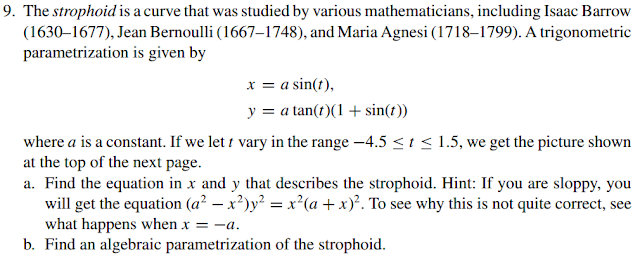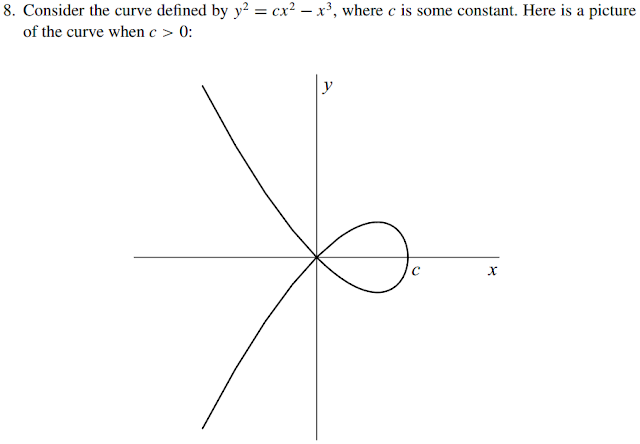Following up with the last post, we wanted to understand why $ xe^{-2x} $ is the solution when $ -2 $ is a repeated root.
Let's start with this, $ (p(x) e^{ax})^{(k)} $
We notice this pattern
$ (p(x)e^{ax})' = e^{ax}(ap(x) + p'(x)) $
$ (p(x)e^{ax})'' = e^{ax}(a^2p(x) + 2ap'(x) + p''(x)) $
$ (p(x)e^{ax})''' = e^{ax}(a^3p(x) + 3a^2p'(x) + 3ap''(x) + p'''(x)) $
Feel like binomial expansion? Let's prove this.
Let $ S(n) $ be the statement $ (p(x)e^{ax})^{(n)} = e^{ax}\sum\limits_{i=0}^{n}(\left(\begin{array}{c}n\\i\end{array}\right)a^i p^{(n-i)}(x)) $
$ S(0) $ is obviously true, now let's assume $ S(k) $ is true and
$ (p(x)e^{ax})^{(k)} = e^{ax}\sum\limits_{i=0}^{k}(\left(\begin{array}{c}k\\i\end{array}\right)a^i p^{(k-i)}(x)) $
Now we differentiate both sides once more, we get
$ (p(x)e^{ax})^{(k+1)} = e^{ax} (\sum\limits_{i=0}^{k}(\left(\begin{array}{c}k\\i\end{array}\right)a^i p^{(k-i)}(x)))' + ae^{ax}\sum\limits_{i=0}^{k}(\left(\begin{array}{c}k\\i\end{array}\right)a^i p^{(k-i)}(x)) $
Don't be shied away from the first term, it is just differentiating polynomials, so adding 1 to the differentiation times and that's all. grouping terms, we will get
$ \begin{eqnarray*} (p(x)e^{ax})^{(k+1)} &=& e^{ax} \sum\limits_{i=0}^{k}(\left(\begin{array}{c}k\\i\end{array}\right)a^i p^{(k+1-i)}(x)) + ae^{ax}\sum\limits_{i=0}^{k}(\left(\begin{array}{c}k\\i\end{array}\right)a^i p^{(k-i)}(x)) \\ &=& e^{ax} \sum\limits_{i=0}^{k}(\left(\begin{array}{c}k\\i\end{array}\right)a^i p^{(k+1-i)}(x)) + ae^{ax}\sum\limits_{i=1}^{k+1}(\left(\begin{array}{c}k\\i - 1\end{array}\right)a^{i-1} p^{(k+1-i)}(x)) \\ &=& e^{ax} \sum\limits_{i=0}^{k}(\left(\begin{array}{c}k\\i\end{array}\right)a^i p^{(k+1-i)}(x)) + e^{ax}\sum\limits_{i=1}^{k+1}(\left(\begin{array}{c}k\\i - 1\end{array}\right)a^i p^{(k+1-i)}(x)) \\ &=& e^{ax} \left(\begin{array}{c}k\\0\end{array}\right)a^0 p^{(k+1-0)}(x) + e^{ax} \sum\limits_{i=1}^{k}(\left(\begin{array}{c}k\\i\end{array}\right)a^i p^{(k+1-i)}(x)) + e^{ax}\sum\limits_{i=1}^{k}(\left(\begin{array}{c}k\\i - 1\end{array}\right)a^i p^{(k+1-i)}(x)) + e^{ax}\left(\begin{array}{c}k\\k+1 - 1\end{array}\right)a^{k+1} p^{(k+1-(k+1))}(x) \\ &=& e^{ax} a^0 p^{(k+1)}(x) + e^{ax} \sum\limits_{i=1}^{k}(\left(\begin{array}{c}k\\i\end{array}\right)a^i p^{(k+1-i)}(x)) + e^{ax}\sum\limits_{i=1}^{k}(\left(\begin{array}{c}k\\i - 1\end{array}\right)a^i p^{(k+1-i)}(x)) + e^{ax}a^{k+1} p^{(0)}(x) \\ &=& e^{ax} a^0 p^{(k+1)}(x) + e^{ax} \sum\limits_{i=1}^{k}(\left(\left(\begin{array}{c}k\\i\end{array}\right)+\left(\begin{array}{c}k\\i-1\end{array}\right)\right)a^i p^{(k+1-i)}(x)) + e^{ax}a^{k+1} p^{(0)}(x) \\ &=& e^{ax} a^0 p^{(k+1)}(x) + e^{ax} \sum\limits_{i=1}^{k}(\left(\begin{array}{c}k + 1\\i\end{array}\right)a^i p^{(k+1-i)}(x)) + e^{ax}a^{k+1} p^{(0)}(x) \\ &=& e^{ax} \sum\limits_{i=0}^{k+1}(\left(\begin{array}{c}k + 1\\i\end{array}\right)a^i p^{(k+1-i)}(x)) \\ \end{eqnarray*} $
Well, a little more complicated than I wanted it to be, but I proved the result.
Next, we assume the differential equation has constant coefficient like this $ \sum\limits_{j=0}^{n} c_j y^{(j)} = 0 $, and that $ r $ is a root of multiplicity $ k $. In this case, we claim $ x^m e^{rx} $ is a solution for the differential equation for $ 0 \le m < k $. All we need to do is to put it back to the equation and use our result above:
$ \begin{eqnarray*} & & \sum\limits_{j=0}^{n} c_j y^{(j)} \\ &=& \sum\limits_{j=0}^{n} c_j e^{rx}\sum\limits_{i=0}^{j}(\left(\begin{array}{c}j\\i\end{array}\right)r^i p^{(j-i)}(x)) \\ &=& e^{rx} \sum\limits_{j=0}^{n} c_j \sum\limits_{i=0}^{j}(\left(\begin{array}{c}j\\i\end{array}\right)r^i p^{(j-i)}(x)) \\ &=& e^{rx} \sum\limits_{j=0}^{n} c_j \sum\limits_{i=0}^{j}(\left(\begin{array}{c}j\\i\end{array}\right)r^{j-i} p^{(i)}(x)) \\ &=& e^{rx} \sum\limits_{i=0}^{n} \sum\limits_{j=i}^{n} c_j (\left(\begin{array}{c}j\\i\end{array}\right)r^{j-i} p^{(i)}(x)) \\ &=& e^{rx} \sum\limits_{i=0}^{n} \sum\limits_{j=i}^{n} c_j (\frac{j!}{i! (j-i)!}r^{j-i} p^{(i)}(x)) \\ &=& e^{rx} \sum\limits_{i=0}^{n} \frac{p^{(i)}(x)}{i!} \sum\limits_{j=i}^{n} c_j (\frac{j!}{(j-i)!}r^{j-i} ) \\ \end{eqnarray*} $
Note that the inner summation is really just the characteristics polynomial differentiated $ i $ times evaluated at $ r $, and we know $ r $ is a root of multiplicity $ k $, so for all $ i < k $, the term is zero.
For the other terms, we differentiated $ p(x) $ at least $ k $ times, but $ p(x) = x^m $, so the derivative vanishes, and those terms go to 0 as well. Combining the two facts, the differential equation is satisfied, and therefore it is a solution!
Q.E.D.
The magic step of the fourth equal sign probably need some explanation. One can better visualize that if one programs, it is basically a loop transformation
for (j = 0 to n) { for (i = 0 to j } { } }
is transformed to
for (i = 0 to n) { for (j = i to n } { } }
The easiest way to see why this transformation is valid is by generating the (i, j) tuples created by these loops.
Let's start with this, $ (p(x) e^{ax})^{(k)} $
We notice this pattern
$ (p(x)e^{ax})' = e^{ax}(ap(x) + p'(x)) $
$ (p(x)e^{ax})'' = e^{ax}(a^2p(x) + 2ap'(x) + p''(x)) $
$ (p(x)e^{ax})''' = e^{ax}(a^3p(x) + 3a^2p'(x) + 3ap''(x) + p'''(x)) $
Feel like binomial expansion? Let's prove this.
Let $ S(n) $ be the statement $ (p(x)e^{ax})^{(n)} = e^{ax}\sum\limits_{i=0}^{n}(\left(\begin{array}{c}n\\i\end{array}\right)a^i p^{(n-i)}(x)) $
$ S(0) $ is obviously true, now let's assume $ S(k) $ is true and
$ (p(x)e^{ax})^{(k)} = e^{ax}\sum\limits_{i=0}^{k}(\left(\begin{array}{c}k\\i\end{array}\right)a^i p^{(k-i)}(x)) $
Now we differentiate both sides once more, we get
$ (p(x)e^{ax})^{(k+1)} = e^{ax} (\sum\limits_{i=0}^{k}(\left(\begin{array}{c}k\\i\end{array}\right)a^i p^{(k-i)}(x)))' + ae^{ax}\sum\limits_{i=0}^{k}(\left(\begin{array}{c}k\\i\end{array}\right)a^i p^{(k-i)}(x)) $
Don't be shied away from the first term, it is just differentiating polynomials, so adding 1 to the differentiation times and that's all. grouping terms, we will get
$ \begin{eqnarray*} (p(x)e^{ax})^{(k+1)} &=& e^{ax} \sum\limits_{i=0}^{k}(\left(\begin{array}{c}k\\i\end{array}\right)a^i p^{(k+1-i)}(x)) + ae^{ax}\sum\limits_{i=0}^{k}(\left(\begin{array}{c}k\\i\end{array}\right)a^i p^{(k-i)}(x)) \\ &=& e^{ax} \sum\limits_{i=0}^{k}(\left(\begin{array}{c}k\\i\end{array}\right)a^i p^{(k+1-i)}(x)) + ae^{ax}\sum\limits_{i=1}^{k+1}(\left(\begin{array}{c}k\\i - 1\end{array}\right)a^{i-1} p^{(k+1-i)}(x)) \\ &=& e^{ax} \sum\limits_{i=0}^{k}(\left(\begin{array}{c}k\\i\end{array}\right)a^i p^{(k+1-i)}(x)) + e^{ax}\sum\limits_{i=1}^{k+1}(\left(\begin{array}{c}k\\i - 1\end{array}\right)a^i p^{(k+1-i)}(x)) \\ &=& e^{ax} \left(\begin{array}{c}k\\0\end{array}\right)a^0 p^{(k+1-0)}(x) + e^{ax} \sum\limits_{i=1}^{k}(\left(\begin{array}{c}k\\i\end{array}\right)a^i p^{(k+1-i)}(x)) + e^{ax}\sum\limits_{i=1}^{k}(\left(\begin{array}{c}k\\i - 1\end{array}\right)a^i p^{(k+1-i)}(x)) + e^{ax}\left(\begin{array}{c}k\\k+1 - 1\end{array}\right)a^{k+1} p^{(k+1-(k+1))}(x) \\ &=& e^{ax} a^0 p^{(k+1)}(x) + e^{ax} \sum\limits_{i=1}^{k}(\left(\begin{array}{c}k\\i\end{array}\right)a^i p^{(k+1-i)}(x)) + e^{ax}\sum\limits_{i=1}^{k}(\left(\begin{array}{c}k\\i - 1\end{array}\right)a^i p^{(k+1-i)}(x)) + e^{ax}a^{k+1} p^{(0)}(x) \\ &=& e^{ax} a^0 p^{(k+1)}(x) + e^{ax} \sum\limits_{i=1}^{k}(\left(\left(\begin{array}{c}k\\i\end{array}\right)+\left(\begin{array}{c}k\\i-1\end{array}\right)\right)a^i p^{(k+1-i)}(x)) + e^{ax}a^{k+1} p^{(0)}(x) \\ &=& e^{ax} a^0 p^{(k+1)}(x) + e^{ax} \sum\limits_{i=1}^{k}(\left(\begin{array}{c}k + 1\\i\end{array}\right)a^i p^{(k+1-i)}(x)) + e^{ax}a^{k+1} p^{(0)}(x) \\ &=& e^{ax} \sum\limits_{i=0}^{k+1}(\left(\begin{array}{c}k + 1\\i\end{array}\right)a^i p^{(k+1-i)}(x)) \\ \end{eqnarray*} $
Well, a little more complicated than I wanted it to be, but I proved the result.
Next, we assume the differential equation has constant coefficient like this $ \sum\limits_{j=0}^{n} c_j y^{(j)} = 0 $, and that $ r $ is a root of multiplicity $ k $. In this case, we claim $ x^m e^{rx} $ is a solution for the differential equation for $ 0 \le m < k $. All we need to do is to put it back to the equation and use our result above:
$ \begin{eqnarray*} & & \sum\limits_{j=0}^{n} c_j y^{(j)} \\ &=& \sum\limits_{j=0}^{n} c_j e^{rx}\sum\limits_{i=0}^{j}(\left(\begin{array}{c}j\\i\end{array}\right)r^i p^{(j-i)}(x)) \\ &=& e^{rx} \sum\limits_{j=0}^{n} c_j \sum\limits_{i=0}^{j}(\left(\begin{array}{c}j\\i\end{array}\right)r^i p^{(j-i)}(x)) \\ &=& e^{rx} \sum\limits_{j=0}^{n} c_j \sum\limits_{i=0}^{j}(\left(\begin{array}{c}j\\i\end{array}\right)r^{j-i} p^{(i)}(x)) \\ &=& e^{rx} \sum\limits_{i=0}^{n} \sum\limits_{j=i}^{n} c_j (\left(\begin{array}{c}j\\i\end{array}\right)r^{j-i} p^{(i)}(x)) \\ &=& e^{rx} \sum\limits_{i=0}^{n} \sum\limits_{j=i}^{n} c_j (\frac{j!}{i! (j-i)!}r^{j-i} p^{(i)}(x)) \\ &=& e^{rx} \sum\limits_{i=0}^{n} \frac{p^{(i)}(x)}{i!} \sum\limits_{j=i}^{n} c_j (\frac{j!}{(j-i)!}r^{j-i} ) \\ \end{eqnarray*} $
Note that the inner summation is really just the characteristics polynomial differentiated $ i $ times evaluated at $ r $, and we know $ r $ is a root of multiplicity $ k $, so for all $ i < k $, the term is zero.
For the other terms, we differentiated $ p(x) $ at least $ k $ times, but $ p(x) = x^m $, so the derivative vanishes, and those terms go to 0 as well. Combining the two facts, the differential equation is satisfied, and therefore it is a solution!
Q.E.D.
The magic step of the fourth equal sign probably need some explanation. One can better visualize that if one programs, it is basically a loop transformation
for (j = 0 to n) { for (i = 0 to j } { } }
is transformed to
for (i = 0 to n) { for (j = i to n } { } }
The easiest way to see why this transformation is valid is by generating the (i, j) tuples created by these loops.



























